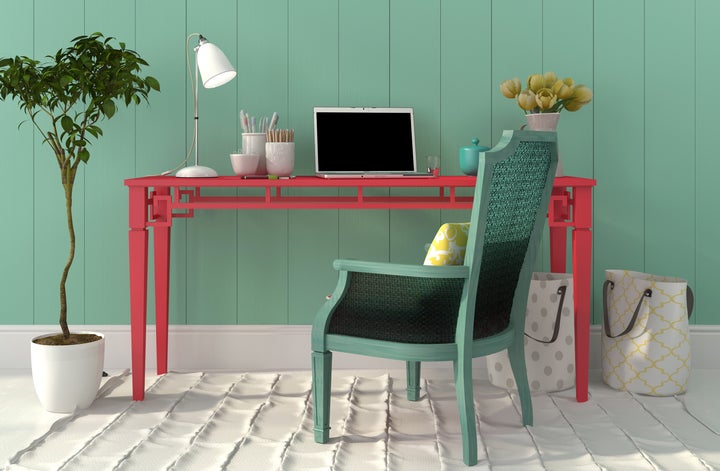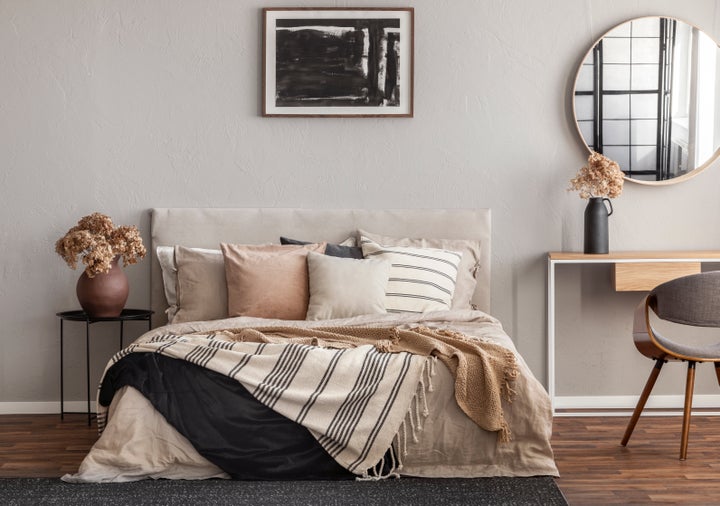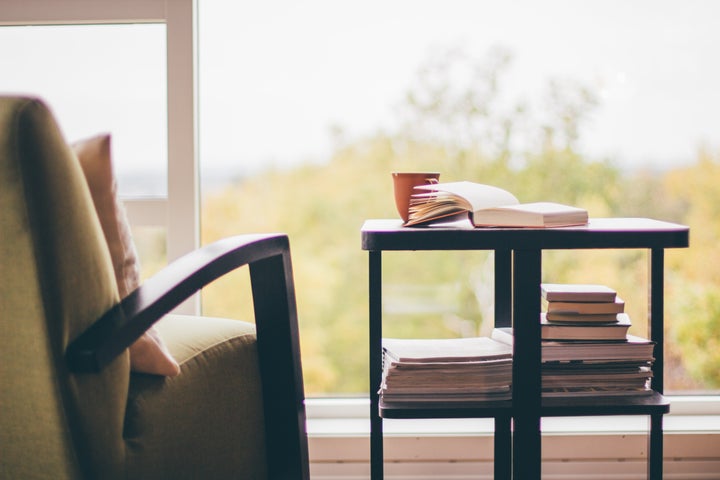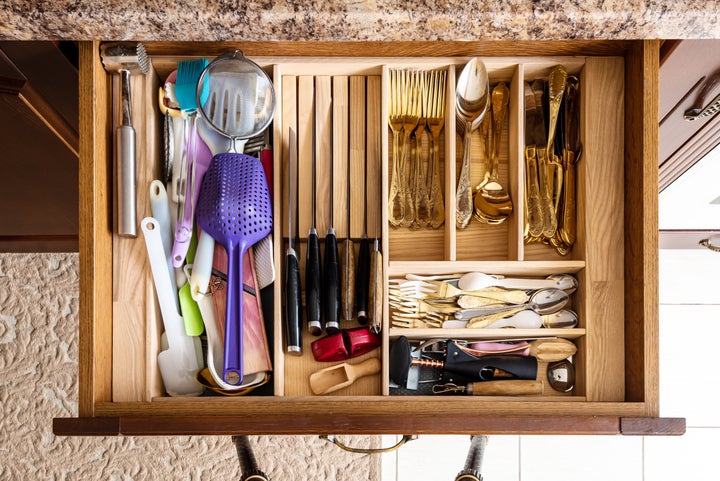With many of us stuck indoors right now, our relationship with our home hangs in the balance. We either feel safe and comforted, or frustrated and trapped.
“A home provides security and an escape – and, when well-designed, can be beneficial to our well-being,” says Niki Schafer, an interior designer who has penned a book on interior design psychology. “However, if it’s just the same old space and you’re used to having a much wider selection of environments from which to access different feelings, then the closed-in feelings can set in.”
Research published this year found a link between diverse, new experiences and increased happiness – so it’s no surprise that being stuck in our homes, not really doing much, can have a negative impact on how we feel.
Add that to the fact our sleep is generally disrupted and our screen-time is up, and you’ve got a recipe for low mood.
The study, published in the journal Nature Neuroscience, revealed people feel happier when they have more variety in their daily routines – so when they go to novel places and have a wider array of experiences.
Researchers monitored participants in New York and Miami for three to four months using GPS tracking, asking them to text in how happy or sad they felt. On days when people had more variability – visiting more places and spending roughly an equal time in these locations – they reported feeling more positive.
While the study was conducted pre-Covid and prior to the huge restrictions it’s imposed on our lives and movement, the researchers did suggest even small changes that introduce greater variability into our physical or mental routine – such as exercising at home, going on a walk around the block, and taking a different route to the grocery store – may yield similarly beneficial effects.
These are just some of the things we can still be doing in lockdown to get a sense of exploration and newness in our lives. But what about a change of scene, even inside our homes?

Schafer believes even small changes around the home can give us a mental lift – although there isn’t any research to show this, it’s purely anecdotal. “These needn’t be expensive or complex,” she says. “How does it feel to change the bed and tidy up the bedroom? Isn’t it better to see a fresh seasonal plant at the front door? Doesn’t it feel good to know the attic is tidy or the space under the bed isn’t jammed full of useless stuff?
“Changing cushions, adding a new throw, buying new bedlinen or moving furniture around can make us smile. The new view can make us appreciate our entire environment. You may not even need to see the result, just knowing the fridge is clean and the cutlery drawers are organised will give you a sense of satisfaction.”
Let’s walk you through what you can do in each room if you’re craving a change.
Sort out your bedroom
Lots of people don’t have the satisfaction of being able to move loads of furniture around in different rooms in their home – in fact, for many in flat or house shares, the bedroom is both a place of work and rest right now.
But there are changes people can make. “The bedroom tends to be a room that has few layout options, unless it’s really big,” says Schafer. “A change of bedlinen is the easiest way to make changes to this room. New cushions and a furry or woollen throw at the end of the bed can make a difference.”
She also recommends adding a dressing table and organising hair and beauty products on it, which can not only be incredibly satisfying, but can double up as a work space if you’re stuck for places to sit (for the sake of your body, you really don’t want to be working on your bed if you can help it). Make sure you put your laptop and work gear away at the end of a day, restoring the area to a dressing table so you don’t feel tempted to do ‘just a bit more’.
Therapists and psychologists are huge advocates of splitting your work space from your rest space to draw a physical line between the two. If you are working from your bed, your brain may start to associate that part of your room with being awake, alert and productive, rather than being relaxed and falling asleep.

Rearrange your living room
Unlike your bedroom, the living room can be easier to rearrange furniture-wise. Schafer urges people to create a good spot to make the most of the morning sun – grab your favourite armchair and move it by a window, for example.
If you’re lucky enough to have a nice view out of the window, whether of the garden or the evening sky, you could face your armchair to it, or even your work desk. We know that spending time in nature is incredibly powerful for wellbeing and can help reduce stress, so surely being able to look at it throughout the day (as opposed to a blank wall) won’t hurt?
Carrie Barron, a psychiatrist from Austin, Texas, is a big believer in rearranging furniture to boost your energy and mood – although it’s all anecdotal, she says many people (women in particular) tell her they feel better for it.
“An impact on the environment, whether an imprint or a removal, lifts mood, provides concrete satisfaction, and instills a sense of effectiveness,” she wrote in Psychology Today. “Inner and outer harmony happen when pieces are placed in a way that makes sense for you. As you rearrange your personal space, you hone your aesthetic and identify what you truly love, want, or need. Such specificity brings relief.”
Some things to think about when rearranging furniture include: the room’s purpose, where your largest pieces will sit, where the focal point in the room is (is it a fireplace, a TV, a large window?), and how to create a sense of symmetry.

Let there be light
With winter coming and daylight hours dwindling, environmental psychologist and wellbeing consultant Lee Chambers recommends working near a window if you can. “The light is more powerful in winter because it’s limited,” he says. “I often suggest people switch up their home office next to a bigger window with more light. When the day is shorter, it’s more important. It really boosts motivation and gets us feeling like we’re not in deep, dark winter.”
A study of how light and colour influences the mood of indoor workers found mood was at its lowest when lighting was experienced as much too dark.
Mood then improved and reached its highest level when the lighting was experienced as just right, but when it became too bright the mood declined again. If you’re struggling with the darker days, adding a couple of lamps to the mix might help to introduce more light without it feeling too clinical – they tend to give a softer light to a room than the much-maligned “big light”.
Organise the kitchen
The kitchen is not really an area that you’d associate with moving around – mainly because the units are pretty fixed unless you’re planning to do some expensive renovations. But Schafer points out that this space can still be de-cluttered and organised better.
“New accessories can add a boost,” she says. “Candles and room infusers can inject new smells and feelings of calm.”
Colour code your cookbooks on a shelf, sort your drawers out, clear your oils and spices into a cupboard so they’re not just sat on the side, empty out your cupboards of tinned goods from 1997.
A tidy space does really help keep a tidy mind. A study of 80 people found they made more errors when working in a messy environment than in a tidy environment. So there are definite benefits to keeping things neat and accessible – whether your workspace, kitchen or any other area in your home.

Think about colour
Getting a change of scene doesn’t just have to be about rearranging furniture or tidying up. If you’re up for a project, perhaps you could paint a feature wall – or even your whole room. “Colour has huge impacts on our wellbeing and health and has been researched extensively,” says Schafer. “Greens and blues make us calmer. Blue is also a productive colour. Neutrals are calm and relaxing.
“Pinks, reds and oranges are lively colours and good for raising spirits – better for the areas you eat and chat, than where you sleep and rest.” She adds: “White is clinical and cold unless it is filled with textures.”
You can also add warmth to a space using texture – this can be achieved with cushions, throws, rugs, as well as introducing natural fibres, wall hangings, curtains and woven baskets to the space. If painting isn’t an option, colourful vases, vibrant plant pots, artwork or posters can add a burst of colour, too.
With winter upon us, Schafer is a big believer in “bringing colour and life into the home”. One way of achieving this is by bringing the garden indoors, she says.
“House plants remind us that we need to look after ourselves as we do them – with water, fresh air and good light.” A study published earlier this year by scientists in Japan, a plant on your desk can reduce stress and anxiety levels.
“Try growing vegetables from seeds,” Schafer adds. “They’re not aesthetically pleasing in tiny pots along the window sill but there’s no greater power than knowing you’ve grown the food on your plate.”